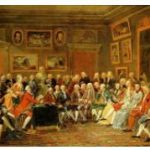The realistic novels
The novels Stendhals and H. de Balzacs, which have both historical and contemporary backgrounds, mark the beginning of the great realistic novel of French literature. Realistic traits also characterize the novellas Mérimées, which often deal with romantic motifs and in some cases exotic milieus. In “Carmen” (1845; German) he created the archetypal character of a seductress and “femme fatale”, shaped by Andalusia and Gypsy stereotypes. In Stendhal’s work, the novel deals with the psychological and social mechanisms with a time-critical tendency (“Le rouge et le noir”, 1830; German “Red and Black”). Balzac In his »Cómedie humaine« (1842–48; German »Die Mensch Komödie«), he used hundreds of characters to depict French society from the French Revolution to the July monarchy in its various social strata, its dynamics and its internal principles.
The romantic authors also followed a different concept in their late novels: with George Sand, while maintaining the feminist perspective (first in »Indiana«, 1832; German), social problems gradually came to the fore (»Le compagnon du tour de France«, 1840; German »The French craftsperson«); Also Hugo pleaded in his novel “Les Misérables” (1862; German “Les Miserables”) for social reform. Both were – along with a number of other authors – under the influence of the ideas of socialist-oriented Catholicism (H. F. R. de Lamennais) and early socialism (C. H. de Saint-Simon, C. Fourier, P. J. Proudhon and others). E. Sue attacked in his novel “Les mystères de Paris” (1842/43; German “The secrets of Paris”), H. Murger in “Scènes de la (vie de) Bohème” (1851; German “Parisian gypsy life…”) the social issue in sentimental-clichéd form. Since the July Revolution of 1830 in particular, many authors were also politically active and had taken a stand for oppositional democratic-liberal ideas (e.g. Lamartine, Vigny, Hugo) with their works . and the establishment of the Second Empire led them to withdraw from public life.
Flaubert succeeded in renewing the realistic representation method with significant consequences: He developed the novel as a means of objectifying representation of external conditions and mental processes. In “Madame Bovary” (1857; German) he dispenses with an evaluative and thus distancing narrative voice by using the “discours indirect libre” (German: “experienced speech”) enlisted for violating public morals. Numerous novelists of the 20th century took up this narrative style, including: through the development to the inner monologue.
The Lyric of Parnasse
Against a literature committed to religious, moral or political goals and also against the use of literature for non-literary purposes, T. Gautier set the principle of L’art pour l’art and thus the freedom from purpose and autonomy of art. With his poetry (“Émaux et camées”, 1852; German “Enamels and Cameos”) he set the trend for the poetry of Parnasse. This group of poets, to which a. C.-M.-R. Leconte de Lisle, T. de Banville, J.-M. de Hérédia and Sully Prudhomme belonged, combined a poetry of the highest and (analogous to the fine arts) artistically sophisticated form rigor with the will to impersonal, objective design and thus represented a conscious reaction to the subjective, soulful poetry of Romanticism. The art conception of L’art pour l ‘ Art and decided aesthetics also characterize the poetry of C. Baudelaire, which – based on an analogy of symbolically referring elements of the universe – aimed at a decomposition and re-creation of reality (“Les fleurs du mal”, 1857; German “The flowers of evil”)) and (also with its sound and language symbolism) became the forerunner of literary symbolism. Baudelaire burst the boundaries of verse poetry in the prose poem, which he – based on the formal model of A. de Bertrand (“Gaspard de la nuit”, 1842) and M. de Guérin - how his poetry made the expression of a specifically “modern” world. Check programingplease.com to see more about France and other countries in the world.
Naturalism
Since the middle of the century, A. Comte’s positivism, with its scientific method-oriented efforts to prove the regularity of all phenomena, has become the guiding theory in various disciplines (e.g. in E. Renan’s religious studies and H. Taine’shistoriography). The positivistic approach, experimental methods of medicine (especially C. Bernard) as well as theses of the theory of evolution (especially C. Darwin) and the milieu theory (Taine) formed the core ideas of literary naturalism. The first novels of this direction were written by the brothers E. and J. de Goncourt. É. Zola formulated the theoretical program of naturalism in a series of essays. Literature should become an instrument of scientific knowledge. In the novel cycle »Les Rougon-Macquart« (1871–93; German »Die Rougon-Macquart«), Zola presents the history of a contemporary family in various milieus – for the first time also in the proletarian – among the genetic, physiological and social factors that determine their development. The description of social problems – especially the material and moral misery of working class families – should at the same time contribute to their elimination; This political commitment was particularly evident in the title of the novel “Germinal” (1885; German), which refers to the revolutionary calendar.
de Maupassant wrote naturalistic short stories and novels in which he critically analyzed the customs of his time. Authors of naturalistic dramas with a socially critical impulse were among others. H. Becque, J. Renard and O. Mirbeau, (u. A. In the succession of comedies during the particularly popular during the Second Empire E. Scribe standing) vaudeville intrigue pieces and customs comedies (z. B. by V. Sardou, E. Labiche, G. Feydeau) supported the ideology and self-image of bourgeois society; critical accents set v. a. É. Augier and A. Dumas fils. The novels and stories by A. Daudet (“Lettres de mon moulin”, 1869; German “Letters from my mill”) are influenced by naturalism but softened by humorous traits.








